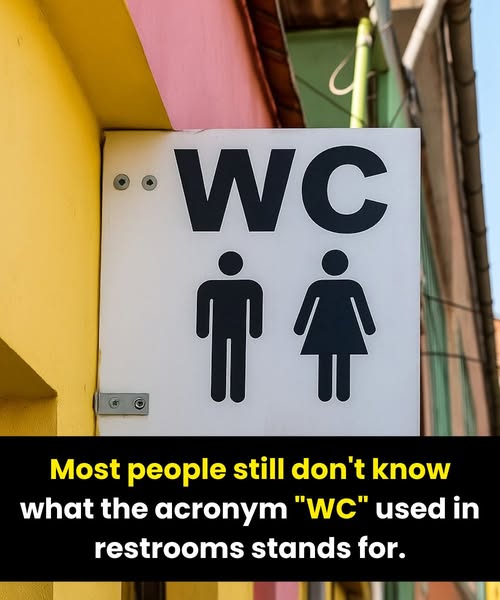Everywhere you travel — airports, train stations, malls, coffee shops, or even tiny roadside diners — you’ll notice one of the most familiar signs on the planet. Sometimes it’s just two letters: “WC.” Other times, it’s a pair of stick figures, one in trousers and the other in a skirt. No matter how they appear, they all point to the same essential place: the restroom. But have you ever stopped to think about where these terms and icons came from? Behind those letters and those simple drawings lies a fascinating story that stretches across history, languages, and cultures.
The Origins of WC
The abbreviation WC stands for Water Closet, a term first used in 19th-century England. At that time, indoor plumbing was a luxury reserved for the wealthy, while most people still depended on outdoor latrines or chamber pots that had to be emptied by hand.
When flush toilets became more common in Victorian households, people needed a new phrase for this private, modern invention. Instead of simply calling it a toilet—a word that originally referred to personal grooming and carried delicate connotations—the phrase Water Closet was born. It distinguished this water-flushing convenience from the older, outdoor privies.
Although the full phrase has faded from everyday English, the abbreviation WC endured. Even today, it remains one of the most recognized terms for a restroom across Europe and Asia, appearing on signs in airports, restaurants, and hotels.
Global Variations in Restroom Terminology
Just as languages differ from country to country, so too do the words people use for restrooms:
United States: The preferred term is Restroom, chosen for its polite and euphemistic tone.
Canada: Canadians usually say Washroom, a slightly more formal word that emphasizes cleanliness.
United Kingdom: Toilet and Loo are most common, though WC is still used, especially on signage.
France & French-speaking regions: Travelers will see Toilettes.
Philippines: A restroom is often called CR, short for Comfort Room.
Australia & New Zealand: The straightforward word Toilet is standard, though WC still appears in older or international contexts.
For travelers, these differences can sometimes be confusing — which is why symbols became so important.
The Rise of Restroom Icons
By the mid-20th century, as global travel increased, it was clear that words alone were not enough. Not every visitor could read or understand the local language. The solution was pictograms — simple, universal images that anyone could recognize.
Designers created the stick figures we know today: one with a triangular dress to represent “female,” and one with straight lines to represent “male.” Their simplicity was intentional, allowing them to be understood instantly, even from a distance.
Over time, these icons became standard in airports, stations, and other busy public places. Their purpose was straightforward: a language-free sign for a universal human need.
Creativity and Local Flavor
Despite the prevalence of standard symbols, many businesses add their own playful twist. A café might use a bowler hat for men and high heels for women. Bars sometimes get cheeky, using a beer mug versus a wine glass. Restaurants might draw from cultural motifs — cowboy boots for men, hoop skirts for women.
While charming, these creative variations can puzzle international visitors. That’s why standardized icons remain essential in high-traffic locations.
The Move Toward Inclusivity
In recent years, restroom signage has also shifted to reflect modern understandings of gender. More public spaces now include gender-neutral restrooms, marked by symbols that combine traditional male and female features, or by straightforward labels such as All-Gender Restroom.
These inclusive signs are more than just practical; they signal dignity, respect, and a step toward recognizing the full spectrum of identity.
Why Restroom Signs Matter
It may seem trivial, but restroom signage plays a vital role. When you’re in an unfamiliar setting, pressed for time, or in urgent need, clarity is everything. A clear WC sign or a familiar icon instantly brings relief and direction.
But beyond function, these signs carry history. From their birth in Victorian England to today’s push for inclusivity, they reflect broader social shifts — from propriety and modesty to accessibility and respect.
Conclusion
The next time you pass a WC sign or spot those stick figures, pause and consider: you’re not just looking at a direction, but at the product of centuries of cultural change, design innovation, and social progress. From the days when indoor plumbing was an elite luxury to today’s global conversations about inclusion, restroom signs tell us as much about society as they do about where to find relief.
At the end of the day, no matter where you are in the world, one truth unites us all: everyone needs to find the restroom. Thanks to WC and its evolving icons, we almost always can.
